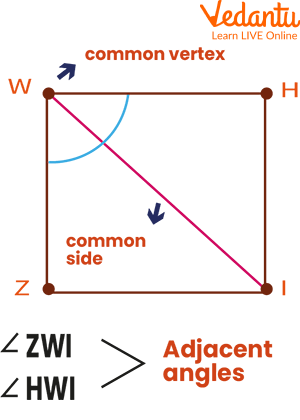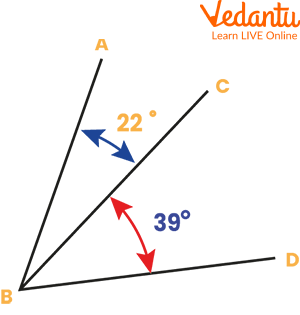




How to Identify Adjacent Angles with a Common Vertex in Geometry
There are numerous examples of adjacent angles in regular activities. The most typical real-world example of adjacent angles is two pizza slices next to one another. The hour, minute, and second hands on a clock, which, when all three are separated from one another, form adjacent angles. The steering wheel of a car has three adjacent angles that we can locate. When two angles are next to each other, the angle created by two non-common arms and one common arm constitutes their sum. Angles that are always placed next to one another, sharing a common vertex and common side but not overlapping, are said to be adjacent angles.
Common Vertex
A vertex that is shared by two angles is known as a common vertex. In other words, the intersection of any two linear structures (like line, line segment, ray) is known as a vertex. Vertices are found at the points where parallel lines and transversals cross, in the corners of polygons, and as the central angles of circles.
Common Side
Two angles having the same vertex can have a common side, which can be a line, ray, or line segment. The common side and one other side are used by both angles.

Common vertex and Common side
What are Adjacent Angles?
Angles that are always placed next to one another, sharing a common vertex and common side but not overlapping, are said to be adjacent angles. So, we can say that a common vertex point is required for making an adjacent angle. In its simplest form, we can say that angles that have a common vertex and side but not overlapping are termed adjacent angles.
Adjacent angles can be distinguished by these characteristics:
The common vertex exists.
The common side exists.

Adjacent Angles
In the above image angles, ABC and CBD are adjacent angles because:
There is a common side that is line CB.
There is a common vertex B.
Examples of Adjacent Angles
Linear Pair
You must try to imagine a cross to fully understand the look of a linear pair. So, four angles are formed when two lines cross. Below image showing two opposite rays with a common vertex.

Linear Pair
The image above shows four angles with the numbers 1, 2, 3, and 4 written next to them. The linear angles in this cross are 1 and 3, 3 and 2, 2 and 4, 4 and 1.
If two angles add up to 180 degrees is a second way to confirm that they are a linear pair. Each pair of supplementary linear angles always sums to 180 degrees.
Vertically Opposite Angles
Even though they are technically not adjacent angles, vertically opposite angles are usually present where adjacent angles are.

Vertical opposite angles
Although they have already been discussed, vertical angles only have one vertex in common and no common sides. If we look at the image above, the angles 3 and 4 and 1 and 2 are viewed as being vertically opposite. The fact that they measure the same is a significant necessity for vertically opposite angles. As an illustration, if angle 1 measures 60 degrees, angle 2 would also be 60 degrees.
Solved Examples
Example 1: Identify all the adjacent angles in the given figure.

Adjacent angles
Ans: Here adjacent angles are:
$\angle \mathrm{AOE}$ and $\angle \mathrm{EOC}$
$\angle \mathrm{E O C}$ and $\angle \mathrm{C O B}$
$\angle \mathrm{C O B}$ and $\angle \mathrm{B O D}$
$\angle \mathrm{B O D}$ and $\angle \mathrm{A O D}$
$\angle \mathrm{A O D}$ and $\angle \mathrm{A O E}$
Example 2: Find the values of $x$ and $y$ since $AOC$ and $BOC$ form a linear pair if $x-y=$ $60^{\circ}$.
Ans: We have given that $x-y=60^{\circ} \ldots$ (i)
We are aware that $x+y=180^{\circ} \ldots$..(ii)
By multiplying (i) and (ii), we get
$2 \mathrm{x}=240^{\circ}$
$\left(240^{\circ} / 2\right)$
$x=120^{\circ} \text {. }$
Therefore,
$120^{\circ}-y=60^{\circ}$
$-y=60^{\circ}-120^{\circ}$
$-y=-60^{\circ}$
$y=60^{\circ}$
Example 3: Identify all the adjacent angles in the given figure.

Adjacent angles
Ans: Here we have the following adjacent angles:
$\angle \mathrm{CHI}$ and $\angle \mathrm{PHI}$
$\angle \mathrm{CHI}$ and $\angle \mathrm{CHU}$
$\angle \mathrm{PHI}$ and $\angle \mathrm{PHU}$
$\angle \mathrm{C H U}$ and $\angle \mathrm{P H U}$
$\angle \mathrm{M U K}$ and $\angle \mathrm{NUK}$
$\angle \mathrm{MUH}$ and $\angle \mathrm{NUH}$
$\angle \mathrm{MUH}$ and $\angle \mathrm{MUK}$
$\angle \mathrm{NUH}$ and $\angle \mathrm{NUK}$
Practice Problem
Q. Are the angles shown below adjacent? Give justifications.

Practice Question
Answer:
1.
(a) No.
(b) No.
(c) No.
(d) Yes.
Summary
In this article we learned that Angles that are always placed next to one another, sharing a common vertex and common side but not overlapping, are said to be adjacent angles. The sum of the adjacent angles formed when a ray is in a straight line is 180°. A linear pair of angles is defined as two adjacent angles whose sum is 180 degrees. Due to the fact that supplementary angles add up to 180°, all linear pairs are supplementary. The supplementary angles do not all have to be linear pairs, though. The lines must cross each other and form adjacent angles in order to form a linear pair. The non-common arms form a line if the product of any two adjacent angles is a straight line.
FAQs on Adjacent Angles and Common Vertex: Definitions & Examples
1. What are adjacent angles? Explain with an example.
Adjacent angles are two angles in a plane that share a common vertex and a common side but do not have any common interior points. In simple terms, they are angles that are right next to each other. For example, in an angle ∠AOC, if a ray OB exists between OA and OC, then ∠AOB and ∠BOC are adjacent angles. They share the common vertex O and the common side OB.
2. What is a common vertex in the context of angles?
A common vertex is the single point where the sides (rays) of two or more angles meet or intersect. For angles to be adjacent, they must share this common point. For instance, think of the centre of a pizza from which all slices are cut. That centre point is the common vertex for the angles of all the slices.
3. What are the three essential conditions for two angles to be considered adjacent?
For any two angles to be classified as adjacent, they must satisfy all three of the following conditions as per the NCERT syllabus:
They must have a common vertex (corner point).
They must have a common arm or side.
Their non-common arms must be on opposite sides of the common arm, meaning the angles cannot overlap.
4. Can two adjacent angles also be complementary? Explain how.
Yes, two adjacent angles can be complementary. This occurs when their sum is exactly 90 degrees. If two adjacent angles are placed next to each other and their non-common sides form a right angle, they are considered adjacent complementary angles. For example, if ∠PQR = 40° and ∠RQS = 50°, and they share the vertex Q and arm QR, they are adjacent angles that are also complementary because 40° + 50° = 90°.
5. What is a linear pair of angles, and how does it relate to adjacent angles?
A linear pair is a special case of adjacent angles. It is a pair of adjacent angles whose non-common sides are opposite rays, forming a straight line. The sum of the angles in a linear pair is always 180 degrees. Therefore, all linear pairs are adjacent and also supplementary, but not all pairs of adjacent angles form a linear pair.
6. What is the key difference between adjacent angles and vertically opposite angles?
The key difference lies in their formation and properties:
Adjacent Angles: They share a common vertex and a common side. They are 'next to' each other. Their sum can be any value, but it is 180° if they form a linear pair.
Vertically Opposite Angles: They are formed when two lines intersect. They share a common vertex but have no common side. They are 'opposite' each other and are always equal in measure.
7. Why are all angles that share a common vertex not necessarily adjacent?
Sharing a common vertex is only one of the three required conditions for angles to be adjacent. The other two conditions are sharing a common arm and having no overlap in their interiors. For example, if you have a large angle ∠XYZ and a smaller angle ∠XYA inside it, they share the vertex Y, but they are not adjacent because one angle is inside the other (they overlap) and they do not have a common arm separating them.
8. Where can we see examples of adjacent angles in real-world objects?
Adjacent angles are very common in our surroundings. Some real-world examples include:
The angles formed by the hour, minute, and second hands on a clock.
Two adjoining slices of a pizza or cake, which share a common cut and the centre point.
The angles formed by the intersecting metal spokes of a bicycle wheel at the hub.
The angle between an open door and the wall next to it.

















